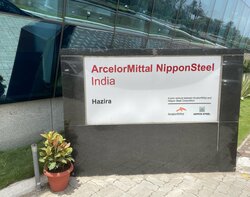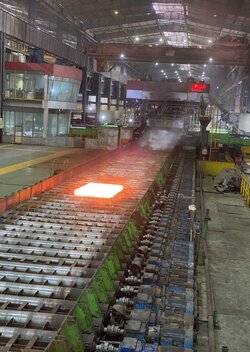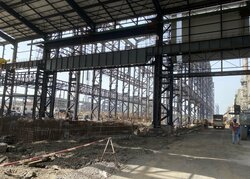In December 2019, Nippon Steel and ArcelorMittal (AM) jointly acquired India’s Essar Steel and established AM/NS India (AMNSI). About 4 years have passed since then, and during that time India has become the world’s second largest crude steel producer, and AMNSI has been steadily growing as well. Last year in September, AMNSI formulated a plan to strengthen and expand their crude steel capacity by 1.7 times. The number of employees dispatched from Nippon Steel has been increased, and the organization is in the process of passing the baton to their ‘second generation’ of managers. How will this new group of managers tackle the ever-growing, enormous Indian market? The Nippon Steel group is envisioning to achieve a ‘global crude steel production of 100 million tons’. AMNSI will play a crucial role in this endeavor, and for the following report we visited AMNSI’s site.

AMNSI’s flagship site is Hazira Steel Plant. The site is located near Surat, Gujarat, which is to the southwest of India’s capital New Delhi and it takes about 2 hours to go there by plane. Surat is famous for its diamond cutting industry, and it is among the 10 largest cities in India with a population of around 7.5 million people.
AMNSI owns land measuring 11 million square meters in size in Hazira, which is an hour’s drive from Surat. The land is near the mouth of the vast Tapti River, which empties into the Indian Ocean. 2 million square meters of the aforementioned land is used for the ‘Hazira Township’, which provides housing for employees. The township also has a hospital, a school and commercial stores. If the land used for the ‘Hazira Township’ is included, the size of the land is close to that of Nippon Steel’s East Nippon Works Kimitsu District.
When we interviewed an executive of Essar Steel 10 years ago, the executive stated “The aim of Hazira Steel Plant is to install a wide range of facilities to create a balanced product mix.”
As the executive mentioned at the time, the production facilities passed on to the current AMNSI are truly diverse. AMNSI has 3 types of facilities, including Midrex modules consisting of 6 direct reduced iron (DRI) plants which serve as their core facilities, and in addition they have 2 coal direct reduction furnaces (Corex process plants) and a single blast furnace (with an inner volume of 2,200 cubic meters) made by a Chinese plant engineering company.
For the steelmaking process for melting sources of steel and adjusting components, AMNSI has 4 electric arc furnaces and 2 CONARC furnaces. In terms of continuous casting, the company operates a ‘CSP’ thin slab continuous caster that is directly linked with a compact hot rolling mill.

For the rolling process, AMNSI has a hot strip mill and a plate mill. For plates, the company can handle widths up to 5,000 mm, the widest plates available from a manufacturer in India, and due to this the company is known to have an advantage in terms of products for the manufacturing industry, including those for construction and industrial machinery. In terms of pipe manufacturing, the company has a mill for manufacturing spiral pipes that use hot rolled coils as mother material, and also a JCO mill for manufacturing large-diameter welded pipes from plates.
In terms of the downstream processes for sheets, the company operates 3 pickling lines, a single cold rolling line and 2 continuous hot-dip galvanizing lines (CGL). In addition, a sheet reroller in Maharashtra originally acquired by Essar Steel in 2009 has now become AMNSI’s Pune Plant and handles the manufacturing of cold rolled sheets, coated sheets and color coated sheets.
During the period spanning from the previous year to this year, AMNSI has made a series of acquisitions of major sheet rerollers. Uttam Galva Steels (currently AM/NS Khopoli) in Maharashtra and Indian Steel Corporation (ISC, currently AM/NS Gandhidham) in Gujarat have newly become part of AMNSI’s downstream process business. As in the case of Pune Plant, both of the new companies are located in western India and are in suitable locations for receiving supplies of base sheets from Hazira, and as production sites that can handle even color coated sheets, they have been contributing to improving the added value provided by AMNSI products.
‘Forests’ Made Up of Numerous Pile Drivers and Cranes
During the most recent April-June quarter, AMNSI’s crude steel production was 1.79 million tons. When annualized, their production will reach around 7-7.5 million tons, and the company is operating at near full capacity due to the favorable conditions brought about by the strong domestic steel demand in India.
Next year AMNSI will raise their annual production to 8 million tons through such measures as solving the bottlenecks in their steelmaking process and through renovating the motors of their hot strip mill. However, even with the expanded capacity it will not be enough to maintain a notable presence in the fast-growing Indian market. Therefore AMNSI has decided to expand their capacity to 14-15 million tons, and last year in October they held a ceremony to commemorate the beginning of construction work for their large-scale plan to expand capacity.
While walking around the grounds of Hazira Steel Plant, you can find ‘forests’ made up of numerous pile drivers and cranes in various areas. Each day around 10,000 workers conduct construction work in the Plant. Even from a global standpoint it is probably rare to see so many construction work to strengthen and expand facilities simultaneously being conducted within a single steel plant.

Among those construction work projects, the largest project involves 4,000 workers, and they are working on newly installing a downstream process line. This project was announced last year in May before the company’s plans for their upstream processes. With this project the company will install a single pickling line tandem cold mill (PLTCM), a single continuous galvanizing and annealing line (CGAL) and 2 continuous hot-dip galvanizing lines (CGL). Among those facilities, the construction work for the No.4 CGL is nearly completed and trial runs have begun toward conducting full-scale operations.
As with the existing 2 CGL, the No.4 CGL will target the building material field. The company states that since the No.4 CGL is a cutting-edge facility, it is capable of manufacturing AM’s corrosion resistant coated sheet ‘Magnelis’. In India there has been an increase in the number of solar power generation projects, and the facility will enable the company to capture demand in the renewable energy field.
Next year AMNSI will begin operating the No.3 CGL and the CGAL which can handle both annealing/cold rolling and the manufacturing of aluminum coated sheets, and with these facilities AMNSI will make a full-fledged entry into the automotive sheet market. Hazira Steel Plant developed its foundational capabilities while AMNSI was still Essar Steel, and now with the capabilities added by AM and Nippon Steel, Hazira Steel Plant is moving toward transforming itself both in terms of scale and quality.